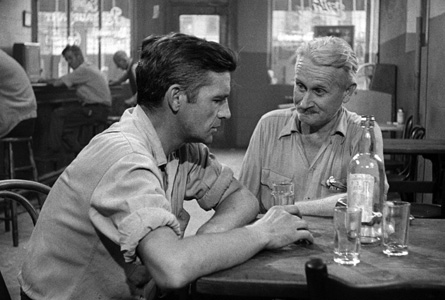
Today if one were to traverse the Bowery in New York’s lower Manhattan you might come away impressed by the gleaming bank buildings, luxury condos, and boutique grocers. In dark corners, however, you may still find a few burned out neon signs dating from another era and lingering as evidence of the Bowery’s faded and none too glamorous past.
On the Bowery, a unique film from 1956 uses a creative technique to get the viewer behind the scenes of what was then a notorious skid row in America’s largest city. A rotting, filthy slum festering away as America showcased its suburbs to the rest of the world as evidence of a capitalist boom time.
The film opens with simple documentary shots of the homeless, drunk, and befuddled drifters who squeeze into doorways for shelter. These battered residents of the Bowery make for a harrowing introduction into the lives of capitalism’s castaways.
A young worker named Ray becomes our tour guide, wandering into a Bowery bar with a cardboard suitcase and a few dollars he earned laboring on the railroad. The film employs no professional actors, and only clearly scripts or stages a few scenes. Mostly the residents are followed around or loosely organized into a scene, which is then ad-libbed and improvised.
Often near Ray’s side is Gorman, an older and savvier resident of the Bowery. Although occasionally glimpsing at the camera or purposefully playing to it, the participants often simply get lost in their own conversation and this is when a few details are revealed. Gorman was once a promising medical student, and his demeanor and remarks occasional betray something of a higher education in his background, but how and when he came to the Bowery remains a mystery. When conversations stall Gorman often asks in all sincerity and hopefulness, “wanna get a drink?” He thus gives voice to the fact that the pursuit of the price of a glass of cheap fortified wine is an all consuming past time for many who dwell here.
Ray at one point mentions that like his brother, he joined the Army, thus causing the audience to wonder if a case of PTSD is likely responsible for his seeking solace in liquor and the solitary life of a drifter. Ray is hardly a ‘bum’, he actively seeks out a days work but the meager wages he earns leaves little hope for advancing beyond the borders of the Bowery. With nowhere to go and little to do the barroom soon calls and Ray is right back where he started.
The bars themselves become a maddening melee of joyful shouts, angry threats and watery promises to pay back past debts. As the night wears on the booze takes hold and the scene looks more like something out of the day room of a primitive mental institution.
The closet thing to a social worker we witness in the film is a drop in mission where, if you are willing to sit through a sermon, you can earn yourself a bowl of hot soup and a place to spend the night. Determined to break the cycle of a days wages wasted on a nights drinking Ray gives it a try. He is ushered along by helpful veterans of the mission experience but is dully informed that there are only so many beds and his place will be on the floor with the rest of the overflow. Yesterday’s newspaper does triple duty as sheet, blanket and pillow.
The motion picture was the product of the late renegade filmmaker Lionel Rogosin who in 1997 wrote that he was considering a project that would document, “The FBI, CIA, Nixon, Kissinger subversion of the U.S. Constitution”. In an interesting footnote, after the film was nominated for an Academy Award, Ray, the movies protagonist, was the recipient of studio film contract offers. This comes as little surprise. When you view the film it would be easy to imagine the strong chin of Ray, who resembled more than a few of the rugged actors of the era, under a steel helmet in a war movie or beneath a dusty cowboy hat in a western. Ray’s response was to say that he just wanted, “to be left alone.”
The Bowery as it once was may be no more, but the problem of homelessness and chronic unemployment remain, often times affecting whole families. This valuable picture is a vivid testimony of the problems that nag a system founded on exploitation.
On the Bowery
Produced and directed by Lionel Rogosin
Starring Gorman Hendricks, Frank Matthews, Ray Silver
1956 65 minutes
Photo: Press still.

MOST POPULAR TODAY

‘Warning! This product supports genocide’: Michigan group aims to educate consumers

Hold the communism, please: SFMOMA’s Diego Rivera exhibit downplays artist’s radical politics

Ohio: Franklin County treasurer attends Netanyahu meeting, steps up Israel Bond purchases

“Trail of Tears Walk” commemorates Native Americans’ forced removal

After months of denial, U.S. admits to running Ukraine biolabs






Comments